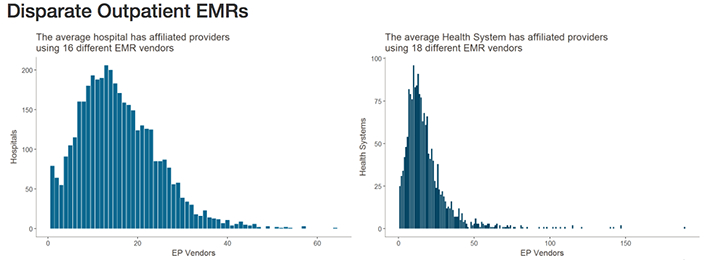Why EHR data interoperability is such a mess in 3 charts

The thorny matter of interoperability in healthcare, as it is or has historically been in other industries, is almost all-consuming among technology vendors and their clients.
Indeed, a big part of the problem is exactly how many EHR companies are out there and, more specifically, the average number of platforms hospitals are running today.
It’s 16. That’s right: 16 distinct electronic health records platforms, according to statistics HIMSS Analytics pulled from its Logic database looking at 571,045 providers affiliated with 4,023 hospitals.

Wait, there’s more. Most hospitals have at least 10 EHRs in place and only two percent are down to just a pair of platforms.
HIMSS Analytics Chief Revenue Officer Mitchell Icenhower explained that the number currently in place doesn’t come up quite that high if you take out specialty EHRs — but doing so is no simple matter.
“The bottom line is there are a lot of different technologies at play here and many of these may be specialty EMRs that won’t be displaced by core vendors, such as behavioral health or oncology products,” added HIMSS Analytics Executive Vice President Blain Newton.
The plot twists even more when considering both inpatient and outpatient settings.

The average health system, in fact, has 18 different EMR vendors when looking all the way across affiliated providers.
It’s not just the reality that implementing, running and maintaining all the different products have created something of mess, either. Healthcare as an industry needs interoperability to be able move forward now that the system is digital.
“This is the reason CMS shifted meaningful use to promoting interoperability,” Icenhower said. “This is the environment health systems work in today — this is the challenge they have, so many data sources, trying to provide a total view of the patient.”
Achieving interoperability among different EHR platforms is so difficult, in fact, that the Centers for Medicare and Medicaid Services working with the Office of the National Coordinator for Health IT, the federal agency charged with leading public and private healthcare organizations toward interoperability, essentially retooled the meaningful use EHR incentive program to focus on enabling a more unified view of patient data. Health IT shops across America, meet “promoting interoperability.”
“There were three steps originally. Get as many hospitals and medical groups to purchase a viable EHR, then to meaningfully use that EHR, and the direction for the third step was to focus on qualitative value and quality measures,” Icenhower added. “Now they’re saying instead of that, ‘we skipped the step where the patient is the center of the universe and their data is spread across different systems,’ so ONC shifted to focusing on the patient.”
Now, about those vendors. In the inpatient setting there’s a whole heap.

The above data points to the healthcare industry’s need for ONC and the Centers for Medicare and Medicaid Services to lead the drive toward interoperability.
“There needs to be a regulatory push here to play referee and determine what standards will be necessary,” Newton added. “But the vendors are going to have to do it because of consumer demand as things like Apple Health Records gain traction.”
Here’s the enormous upside, though: True interoperability will spark innovation and not just between EHR makers competing for best of breed but, more important, among innovators that don’t even sell EHRs as health data starts to flow.
“Even though there may be fewer vendors each feels the need to open up and enable innovation,” Icenhower said, and rattled off Epic, Cerner, Allscripts and athenahealth among those that now need to figure this out. Newton added: “You’re going to see consumer health apps that have been playing on the fringes now be able to plug into the mothership and pull data from it, add to it.”
That’s the scope of the interoperability problem: When tech vendors and hospitals enable data to flow more effectively, the real innovation can begin.
Read more Innovation Pulse columns from Healthcare IT News.
Twitter: SullyHIT
Email the writer: tom.sullivan@himssmedia.com

























